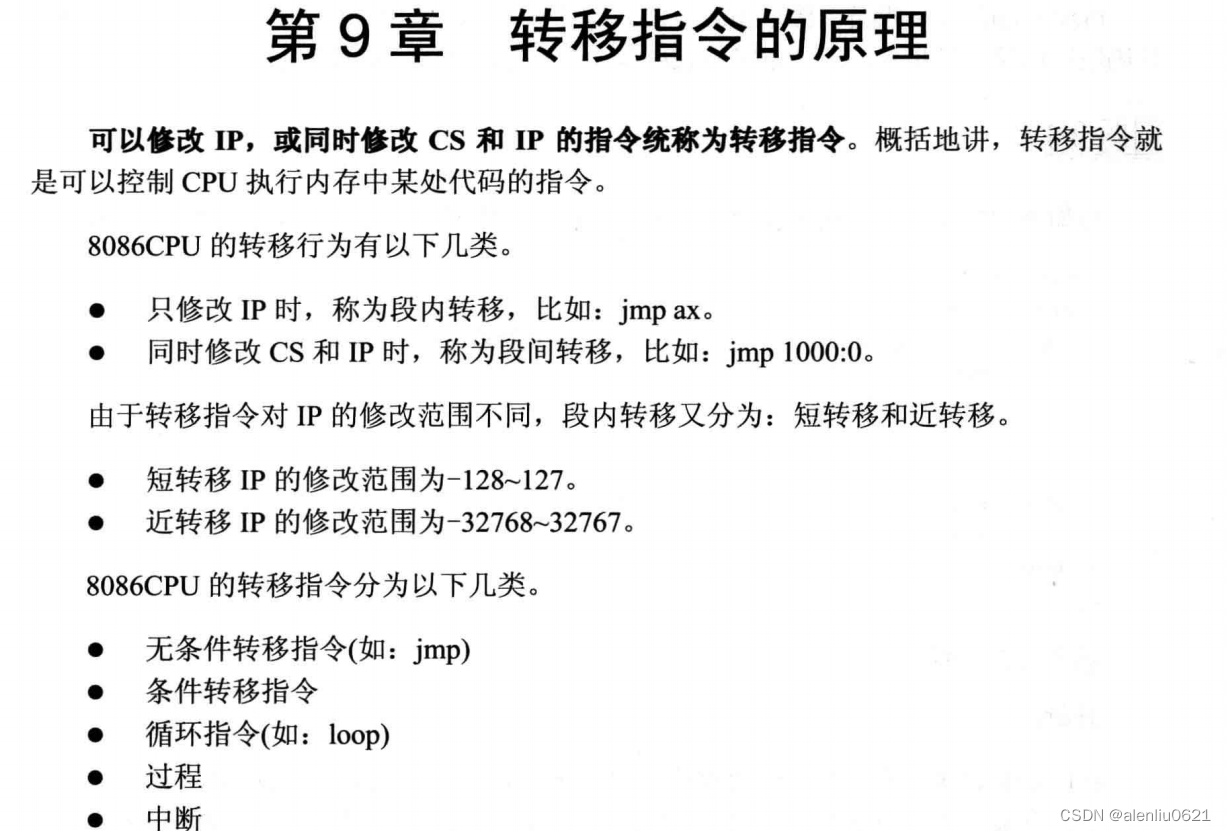前言
直接看《汇编语言》书中介绍转移指令的内容:

这篇文章就来讲一下 jmp 指令的翻译。
jmp 汇编指令的格式
jmp 汇编指令的形式一共有如下几种:
- jmp short 标号。段内短转移。
- jmp near ptr 标号。段内近转移。
- jmp far ptr 标号。段间转移,称为远转移。
- jmp 16 位寄存器。
- jmp word ptr 内存单元地址。段内转移。
- jmp dword ptr 内存单元地址。段间转移。
- jmp 标号。我实现的时候将它当做段内近转移。
jmp 机器指令的格式
jmp 机器指令格式如下:

段内近转移。对应汇编 “jmp near ptr” 标号 和 “jmp 标号” 两种形式。
段内短转移。对应汇编“jmp short 标号”的形式。
段内间接转移。对应汇编“jmp 16 位寄存器”和“jmp word ptr 内存单元地址”两种形式。
段间直接转移。对应汇编“jmp far ptr 标号”的形式。
段间间接转移。对应汇编“jmp dword ptr 内存单元地址”的形式。
jmp 指令的翻译
jmp 操作数类型
jmp 汇编指令有这么多格式,首先要做的就是区分操作数的类型。
所以先定义 jmp 操作数类型:
type JmpOperandType uint8
const (
JmpLabelOperand JmpOperandType = iota
JmpShortLabelOperand
JmpNearLabelOperand
JmpFarLabelOperand
JmpRegOperand
JmpWordMemOperand
JmpDwordMemOperand
JmpInvalidOperand
)
解析操作数
然后就是解析字符串,区分是哪种操作数类型:
func getJmpOperand(operand string) JmpOperand {
fields := strings.Fields(operand)
len := len(fields)
switch len {
// jmp s1 , jmp ax
case 1:
if t, v := isReg16Operand(fields[0]); t {
return JmpOperand{
JmpRegOperand, v}
}
return JmpOperand{
JmpLabelOperand, fields[0]}
// jmp short s1
case 2:
return JmpOperand{
JmpShortLabelOperand, fields[1]}
// jmp near ptr s1, jmp far ptr s1, jmp word ptr [bx+si+123], jmp dword ptr [bx+si+123]
case 3:
switch fields[0] {
case "near":
return JmpOperand{
JmpNearLabelOperand, fields[2]}
case "far":
return JmpOperand{
JmpFarLabelOperand, fields[2]}
case "word":
if t, v := isSimpleMemOperand(fields[2]); t {
return JmpOperand{
JmpWordMemOperand, v}
}
return JmpOperand{
JmpInvalidOperand, nil}
case "dword":
if t, v := isSimpleMemOperand(fields[2]); t {
return JmpOperand{
JmpDwordMemOperand, v}
}
return JmpOperand{
JmpInvalidOperand, nil}
}
}
return JmpOperand{
JmpInvalidOperand, nil}
}
checkJmp 的实现
func checkJmp(stmt []string) (bool, context.Context) {
fields := strings.Fields(stmt[1])
len := len(fields)
if len > 3 {
log.Fatalf("0 invalid \"%s\" syntax", stmt[0])
}
if len == 2 {
if fields[0] != "short" {
log.Fatalf("1 invalid \"%s\" syntax", stmt[0])
}
} else if len == 3 {
if fields[1] != "ptr" {
log.Fatalf("2 invalid \"%s\" syntax", stmt[0])
}
if fields[0] != "near" &&
fields[0] != "far" &&
fields[0] != "word" &&
fields[0] != "dword" {
log.Fatalf("2 invalid \"%s\" syntax", stmt[0])
}
}
operand := getJmpOperand(stmt[1])
if operand.Type == JmpInvalidOperand {
log.Fatalf("3 invalid \"%s\" syntax", stmt[0])
}
var k encodeCtxKey
ctx := context.Background()
k = encodeCtxKey("dst")
ctx = context.WithValue(ctx, k, operand)
table := map[string]uint8{
"jmp": InstructionJmp,
"call": InstructionCall,
}
k = encodeCtxKey("type")
ctx = context.WithValue(ctx, k, table[stmt[0]])
return true, ctx
}
因为 call 指令和 jmp 指令的格式类似,所以这里我是将它们放在一起实现的。所以在 ctx 里面加了个"type" key 用来区分是 jmp 指令还是 call 指令。
call 指令的格式如下:

encodeJmp 的实现
func encodeJmp(ctx context.Context) []byte {
var instruction []byte
dstOperand := ctx.Value(encodeCtxKey("dst")).(JmpOperand)
dstOperandType := dstOperand.Type
instructionType := ctx.Value(encodeCtxKey("type")).(uint8)
switch dstOperandType {
// jmp short s1
case JmpShortLabelOperand:
dst := dstOperand.Value.(string)
instruction = encodeJmpDirectWithinsegmentShort(dst)
// jmp s1, jmp near ptr s1, call s
case JmpLabelOperand, JmpNearLabelOperand:
dst := dstOperand.Value.(string)
instruction = encodeJmpDirectWithinsegment(instructionType, dst)
// jmp far ptr s1, call far ptr s
case JmpFarLabelOperand:
log.Fatal("jmp not support far ptr")
dst := dstOperand.Value.(string)
instruction = encodeJmpDirectIntersegment(dst)
case JmpRegOperand:
dst := dstOperand.Value.(*RegOperand)
instruction = encodeJmpRegIndirectWithinsegment(instructionType, dst)
case JmpWordMemOperand:
dst := dstOperand.Value.(*MemOperand)
instruction = encodeJmpIndirectWithinsegment(instructionType, dst)
case JmpDwordMemOperand:
dst := dstOperand.Value.(*MemOperand)
instruction = encodeJmpIndirectIntersegment(instructionType, dst)
default:
log.Fatal("error encodeing jmp")
}
return instruction
}
看下段内近转移的编码函数 encodeJmpDirectWithinsegment 的实现:
// jmp near ptr s1, jmp s1, call s
func encodeJmpDirectWithinsegment(instructionType uint8, label string) []byte {
/*11101001,IP-INC-LO,IP-INC-HI*/
var instruction []byte
if instructionType == InstructionJmp {
instruction = append(instruction, 0b11101001)
} else if instructionType == InstructionCall {
instruction = append(instruction, 0b11101000)
}
instruction = append(instruction, 0)
instruction = append(instruction, 0)
putJmpLabelEncodeInfo(label, 1, 16, 3)
return instruction
}
注意,jmp 的偏移量翻译成机器指令的时候,它的值是 0。
然后调用 putJmpLabelEncodeInfo(label, 1, 16, 3),将标号的信息记录。
putJmpLabelEncodeInfo 的实现如下:
func putJmpLabelEncodeInfo(name string, offsetInInstruction uint8, width uint8, instructionLen uint8) {
labelEncodeInfos = append(labelEncodeInfos,
LabelEncodeInfo{
Name: name,
Offset: progOffset + uint32(offsetInInstruction),
Width: width,
IsJmpLable: true,
JmpInc: codeOffset + uint16(instructionLen),
})
}
再看下标号信息结构的定义:
var labelEncodeInfos []LabelEncodeInfo
type LabelEncodeInfo struct {
Name string // 标号名称
Offset uint32 // 标号在程序中的偏移量
Width uint8 // 标号值的宽度
IsOffsetLabel bool // 是否是 offset 标号
IsJmpLable bool // 是否是 jmp 指令中的标号
JmpInc uint16 // jmp 指令下一条指令在代码段中的偏移量
}
来理解下 putJmpLabelEncodeInfo(label, 1, 16, 3) 四个参数。
第一个参数是标号名称。
第二个参数是 jmp 偏移量在机器指令中的偏移量。

从格式里看到,表示 jmp 偏移量的 IP-INC-LO,IP-INC-HI 字段在指令中是第2字节开始的,所以 offsetInInstruction 参数是 1。putJmpLabelEncodeInfo 里添加的标号结构里将这个参数值加上 progOffset 变量的值就得到了这个标号在程序中的偏移量!【后续文章介绍它的作用】
第三个参数是 jmp 偏移量的宽度 16 位。
最后一个参数是编码后机器指令的长度,也就是 3 字节。putJmpLabelEncodeInfo 里添加的标号结构里将这个参数值加上 codeOffset 变量的值就得到了这个指令下一条指令相对代码段的偏移量!【后续文章介绍它的作用】
搞定了 mov 和 jmp 指令的翻译,其他指令都是类似的,想要加上什么指令按照这种思路添加就行了。